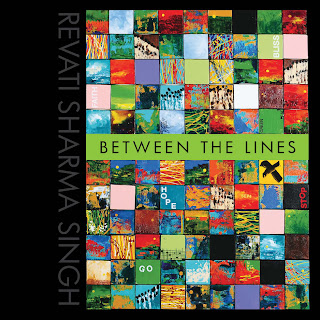Summer holidays have begun and most of the children have either gone off for a vacation to far off places or they are busy watching TV or are on the net. There are some of them who have come to Mumbai to spend their holidays, I see them enjoying, playing outdoor games in the building compound and I am sure most of them would be interested in watching films, especially children’s films.
Now who doesn’t like watching children’s films, especially if the actors are children themselves?
Specially if they are films like Santosh Sivan's 'Halo' and 'Malli', Sai Paranjpye's 'Bhago Bhoot', Pankaj Advani's 'Sunday', Sankalp Meshram's 'Chutkan ki Mahabharat' or Batul Mukhtiar’s 'Lilkee'
Surely they will like to see ‘Halo’, a story of seven-year-old Sasha's search for her pup who's got lost on the streets of Mumbai.
Or maybe 'Lilkee', a story of an11-year-old village girl, brought to the city by a working couple to take care of their baby.
Yeah! The Children's Film Society, India is organizing a summer bonanza of its films to be shown from 3 May 2010 to 31 May 2010. The films are on Mondays, Wednesdays and Fridays every week of the month of May, 2 shows, one at 11 am, and one at 4 pm.
For details of screening of films and the show timings, film synopsis and other information, please click here
The films will be screened at the Films Division Preview Theater. Seating is available on a first come, first serve basis. Admission is free, but it would be best to book your passes in advance.
Passes are available at
Children’s Film Society, 8th Floor,
Films Division Complex, 24, Pedder Road, Mumbai -26.
Phone: 2352 2870/ 2351 6127
Email: creative@cfsindia.org/ marketing@cfsindia.org
All the children, whom I used to take for children’s film are grown ups now and are in their naughty age, but what the heck…. I still enjoy children’s film and I might as well go with my friends who share my taste.
What say you??
Thursday, 29 April 2010
Thursday, 22 April 2010
Mudra Dance Week
When I lived abroad, what I missed most were Indian dances which are so graceful and expressive, and with those costumes and make-up, the rhythm and grace, it gives a different kind of experience which cannot be matched with any Bollywood dances. During Indian festival, I would always suggest to the Indian community to organize an Indian cultural show with traditional dances and when there were visiting dancers from India, the show would be houseful.
But here in Mumbai, we are lucky. We have NCPA, where we can watch regular cultural shows and this week there is Mudra Dance week from 26th to 30th April 2010, which offers fascinating glimpse into the world of Indian Dances today.
The theme this year is ‘Stree’ (meaning Woman) in various styles from Manipuri to Nagiar Koothu, from Bharata Natyam to Kathak, reflecting the moods of woman in various ways. The performances range from seasoned to classical to contemporary.
April 26: Matrika (and other compositions) by Bimbavati Devi and Troupe. A leading Manipuri dance troupe presents the classical, folk and martial aspects of its art, including a significant paean in praise of the mother goddess, Matrika.
April 27: Sita Parityagam (The Abandoning of Sita) — Nangiar Koothu Recital by Kapila Nagavallikkunnel. An acclaimed Nangiar Koothu exponent interprets the moving story of Sita’s fire ordeal.
April 28: Amrutam — Bharata Natyam Recital by Lata Surendra. A sprightly Bharata Natyam dance group celebrates the verses of two great Indian women mystics: Andal and Meerabai.
April 29: Amrapali — Mohini Attam Recital by Neena Prasad. A well-known Mohini Attam dancer, committed to exploring the contemporary within the classical framework, focuses on Amrapali, the great courtesan and follower of the Buddha.
And finally, April 30: Devi — Kathak Dance Theatre Presentation by Purva Naresh and others. A dynamic young Kathak dancer-choreographer-actor and her team celebrate the Devi and her manifestations in the modern world.
Stop by NCPA and enjoy the bliss
Friday, 16 April 2010
Literacy in Mumbai city
Everybody in Mumbai knows to read and write. Er.. Well.. Almost everybody.
Yeah! I have reason to think that everybody in Mumbai knows to read and I would include street children too. It matters not that some of them have no time to go to school, working on the street is a hard job and these kids do a great job begging and earning for their parents, and yet they are smart, well that is for another day, here I am thinking that they can read and write, maybe not word by word, or alphabet by alphabet but they are expert in sight reading and this is all thanks to the big, huge hoarding that you see at every street.
Mumbai is the commercial city and every corner of the Mumbai is used up by hoardings or knowledge pads if you might call that.
Be it at the bus stop,
or on the top of the building
At road dividers
the education aids are there…everywhere....and you always wondered whether children in Mumbai know to read and write…
There! Now you know it.
Yeah! I have reason to think that everybody in Mumbai knows to read and I would include street children too. It matters not that some of them have no time to go to school, working on the street is a hard job and these kids do a great job begging and earning for their parents, and yet they are smart, well that is for another day, here I am thinking that they can read and write, maybe not word by word, or alphabet by alphabet but they are expert in sight reading and this is all thanks to the big, huge hoarding that you see at every street.
Be it at the bus stop,
or on the top of the building
At road dividers
Or at middle of the road
the education aids are there…everywhere....and you always wondered whether children in Mumbai know to read and write…
There! Now you know it.
Friday, 9 April 2010
For artist who can read between lines
If you were there for Kala Ghoda Festival 2010 in Mumbai, you might have noticed the art installation at main square under the title ‘Mera Desh Mahaan’ A thought-provoking installation represents a dialogue with society about its values and disposition as a role model for today’s younger generation. That was work of artist Revati Sharma Singh, who believes, “Art is subjective. There can be nothing objective about it, either for the artist or the person looking at the artwork. The process mirrors life.”
Between the Lines
"Lines form a basis of who we are.
When we think of lines, we probably think of lines that divide.
They may be borders which divide one country from another. They may be religion, dividing one home from another. They may be monetary distinction bringing the barrier between rich and poor.
There are a few lines, though not visible to the naked eye, are always present. It may include the lines in our relationships, the lines of caste and creed of colour and also the lines between truth and deceit.
Despite these divisions, there are lines that unite.
That may be an umbilical cord uniting a mother with her child. The heritage passes down to the next generation, uniting two generations. Though there are borders, there are also lines which connect one country to another. The lines on our palms define and create our destiny. Our bones fuse together to make the most complex forms – our bodies.
The most important lines may be that of communication, forming the basis of all different languages and dialects where love, peace and war mean the same thing in different languages to all the people."
Source
"Revati is a sensitive artist who expresses her art through her conscience, A painter and installation artist, Revati’s simultaneously complex and detailed creations reflect sensitivity to urban alienation and cultural displacement.
Revati Sharma Singh can easily be described as one of India’s thinking artists. Her works provoke deep thought and make for a visual journey that inspires the mind’s eye. It’s in her atelier that she finds herself at peace and one with the issues that deeply concern her – they maybe the disintegration of our value systems or even the lines that divide us.
Her art lends itself to wholesome sentiments – sentiments that lighten or beset our daily life. This unique exhibition offers the viewer a sublime experience through works on canvas."
Between the Lines
"Lines form a basis of who we are.
When we think of lines, we probably think of lines that divide.
They may be borders which divide one country from another. They may be religion, dividing one home from another. They may be monetary distinction bringing the barrier between rich and poor.
There are a few lines, though not visible to the naked eye, are always present. It may include the lines in our relationships, the lines of caste and creed of colour and also the lines between truth and deceit.
Despite these divisions, there are lines that unite.
That may be an umbilical cord uniting a mother with her child. The heritage passes down to the next generation, uniting two generations. Though there are borders, there are also lines which connect one country to another. The lines on our palms define and create our destiny. Our bones fuse together to make the most complex forms – our bodies.
The most important lines may be that of communication, forming the basis of all different languages and dialects where love, peace and war mean the same thing in different languages to all the people."
Source
Subscribe to:
Comments (Atom)
The name "Bombay" was derived from 'Bom Bahia' (The Good Bay),
.... a name given by Portuguese sailor Francis Almeida, in 1508 ....“Bounce back Mumbai” .....as it is called by the locals, it is a city that has been through a lot in the recent past – floods, bomb blasts, riots – and come out stronger each time.
Whats the Time Please?
Live Exchange Rates
Do you love what you read here? .....Copy, churn, reproduce, share or imitate....knowledge is for sharing....But, do acknowledge me, or better still.... send me a copy....... pmoorjani@yahoo.com










